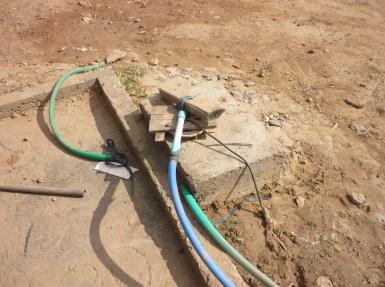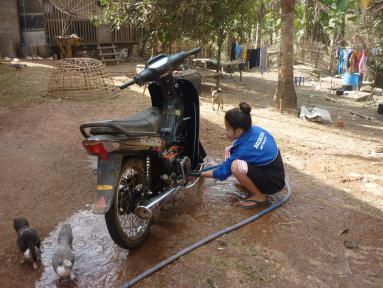Until recently, there were no reliable data regarding ground water level and groundwater conditions and risks within the Nam Ton Watershed. The knowledge was based on basic observations and interviews showing that shallow ground water may be found at a depth of a few meters up to 30 meters. Traditional wells in villages are tapping this resource, which can deplete rapidly according to the seasons and conditions of use.
In the last decades, tube wells had been drilled generally for groups of householders and was equipped with hand pumps. The depth of the water is approximately 30 m (with of course spatial variability). This was described in the Basin Profile 2008. Those hand pumps could allow the tapping of the groundwater in a range generally less than 1 m3/hour.
What is observed now is the rapid increasing in the number of "family" tube wells equipped with electric pumps. This is causing a change in the habits for the use of water for domestic purposes. The water is also used for gardening in the immediate vicinity of the houses.
It is therefore essential to get a good understanding of the recharge of the aquifers. It is likely that the rate of infiltration during the rainy season is high. In the upper watershed, the soils does not show signs of deep degradation and even the shifting cultivation, unless done on steep slope, should not change to much the infiltration rate. In the low land, the wide development of paddy fields constitute favorable conditions for recharging the aquifers. This situation can change in places where soil conditions are modified (mining, deforestation and earthworks, especially on steep slopes).
Promoting the development of paddy fields in flat areas of the upper part of NTW in place where shifting cultivation is now practised and promote small natural reservoirs for rainfall harvesting is likely to have very positive impacts in terms of recharge of the aquifers and reduction of flash flood.
In summary, the use of the groundwater may be a good opportunity for the future in terms of water availability for both domestic water and irrigation (using more advanced technologies such as drip irrigation and less-water consuming crops). In that way, tapping groundwater rather than surface water may decrease the present pressure observed on surface water and contribute to maintain and restore the aquatic ecosystems. On another hand, if the aquifer is over-exploited and if rules for tapping the ground waters are not implemented, particularly in the upper-catchment and in general in the shallow aquifers, it may be a threat for the whole surface water system.
The potential (recharge of the aquifers in the rainy season) and the risks and opportunities in developing a strategy aiming at tapping the aquifers must be explored in the framework of SUMALOM NT project
 |
 |
| Fast change in the use of groundwater | …which modifies the water use habits… |
